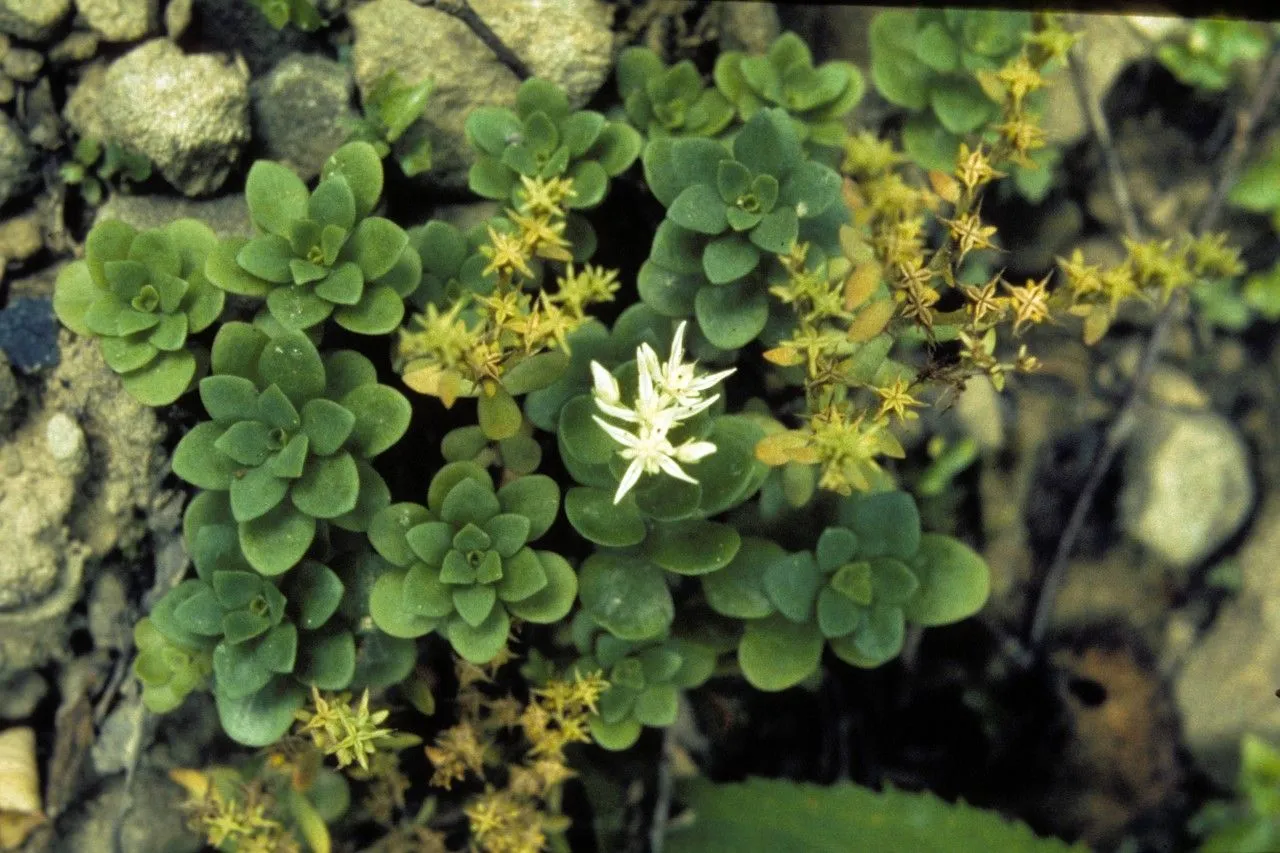
Author: Michx.
Bibliography: Fl. Bor.-Amer. 1: 277 (1803)
Year: 1803
Status: accepted
Rank: species
Genus: Sedum
Vegetable: False
Observations: SE. Canada to NC. & E. U.S.A.
Wild stonecrop, known scientifically as Sedum ternatum, is a charming and resilient perennial plant that belongs to the Crassulaceae family. Celebrated for its versatility and hardiness, this plant is native to the southeastern regions of Canada down through North Carolina and across the eastern United States, showcasing its capacity to thrive in a variety of environments.
Characterized by its succulent, green foliage and delicate white star-shaped flowers, wild stonecrop typically blooms in the late spring to early summer. The leaves are thick and fleshy, a common trait among members of the Crassulaceae family, which allows the plant to retain water efficiently. This adaptation is particularly beneficial for survival in rocky or sandy soils where water drainage is rapid.
The natural habitats of Sedum ternatum include woodlands, rocky slopes, and along stream banks. Its ability to grow in shaded areas makes it a valuable ground cover option for gardens with varying light conditions. Typically, wild stonecrop forms dense mats that not only enhance the aesthetic appeal of natural and cultivated landscapes but also help to control soil erosion.
Michaux first documented this species in 1803, recognizing its unique characteristics and the ecological benefits it provides. Gardeners and botanists alike appreciate wild stonecrop for its low maintenance needs and its propensity to attract pollinators like bees and butterflies, thereby supporting local ecosystems.
In addition to its ornamental uses, wild stonecrop can play a role in ecological restoration projects. Its resilience to different soil types and conditions makes it an excellent candidate for reviving degraded landscapes. Moreover, its low growth habit and spreading nature allow it to outcompete invasive species, which is integral in maintaining the health and balance of native plant communities.
For anyone interested in incorporating a versatile and adaptive plant into their garden, wild stonecrop is an exceptional choice. Its combination of durability, ecological benefits, and understated beauty make it a remarkable addition to both natural and cultivated environments.
Eng: wild stonecrop, woodland stonecrop
Swe: skogsfetknopp
Fra: orpin terné
En: Wild stonecrop, Woodland Stonecrop
Fr: Orpin terné
Sv: Skogsfetknopp
: Woodland stonecrop
Taken Apr 6, 2021 by katie moyer (cc-by-sa)
Taken Aug 6, 2021 by Jacob von der Sandgrube (cc-by-sa)
Taken Jul 22, 2022 by michelle padavano (cc-by-sa)
Taken Feb 24, 2021 by Catherine Tapson (cc-by-sa)
Taken Aug 9, 2022 by marisa kintzel (cc-by-sa)
Taken Jun 29, 2020 by Rusudan Bregadze (cc-by-sa)
Taken May 3, 2020 by Serena Schade (cc-by-sa)
Taken May 9, 2021 by Katherine M. Hickey (cc-by-sa)
Taken May 17, 2020 by Marshall Aanestad (cc-by-sa)
Taken Sep 22, 2019 by Chastity R (cc-by-sa)
Taken Jan 1, 1900 by EOL − WVU Herbarium (cc-by-nc-sa)
Taken May 3, 2014 by EOL − Christopher Tracey (cc-by-nc-sa)
Taken May 5, 2013 by EOL − Dan Nydick (cc-by-nc)
Taken Mar 20, 2016 by EOL − Robert L Curtis (cc-by-nc-sa)
Taken Apr 29, 2014 by EOL − Evan Raskin (cc-by-nc)
Taken Mar 18, 2021 by Disa Villada (cc-by-sa)
Taken May 31, 2003 by EOL − Steven J. Baskauf (cc-by-nc-sa)
Growth habit>: Forb/herb
Family: Myrtaceae Author: (F.Muell.) K.D.Hill & L.A.S.Johnson Bibliography: Telopea 6: 402 (1995) Year: 1995 Status:…
Family: Rubiaceae Author: Pierre ex A.Froehner Bibliography: Notizbl. Bot. Gart. Berlin-Dahlem 1: 237 (1897) Year:…
Family: Sapindaceae Author: Koidz. Bibliography: J. Coll. Sci. Imp. Univ. Tokyo 32(1): 38 (1911) Year:…
Family: Asteraceae Author: A.Gray Bibliography: Pacif. Railr. Rep.: 107 (1857) Year: 1857 Status: accepted Rank:…
Family: Fabaceae Author: Medik. Bibliography: Vorles. Churpfälz. Phys.-Ökon. Ges. 2: 398 (1787) Year: 1787 Status:…
Family: Aspleniaceae Author: (Cav.) Alston Bibliography: Bull. Misc. Inform. Kew 1932: 309 (1932) Year: 1932…